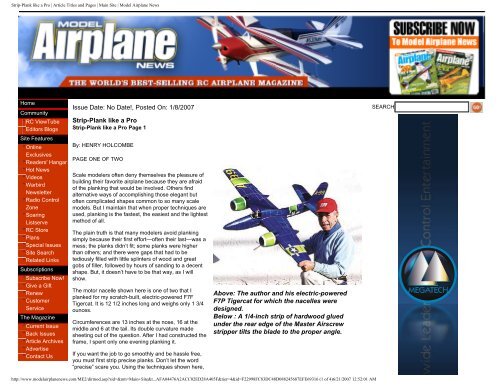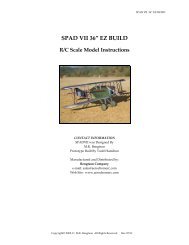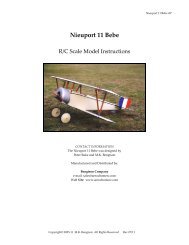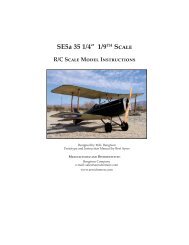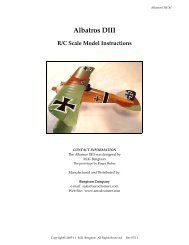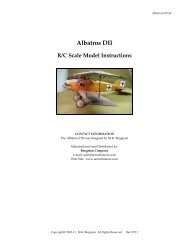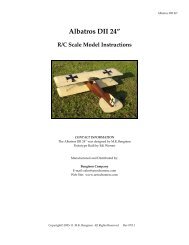Strip-Plank like a Pro | Article Titles and Pages | Main ... - RC Universe
Strip-Plank like a Pro | Article Titles and Pages | Main ... - RC Universe
Strip-Plank like a Pro | Article Titles and Pages | Main ... - RC Universe
You also want an ePaper? Increase the reach of your titles
YUMPU automatically turns print PDFs into web optimized ePapers that Google loves.
<strong>Strip</strong>-<strong>Plank</strong> <strong>like</strong> a <strong>Pro</strong> | <strong>Article</strong> <strong>Titles</strong> <strong>and</strong> <strong>Pages</strong> | <strong>Main</strong> Site | Model Airplane News<br />
Home<br />
Community<br />
<strong>RC</strong> ViewTube<br />
Editors Blogs<br />
Site Features<br />
Online<br />
Exclusives<br />
Readers' Hangar<br />
Hot News<br />
Videos<br />
Warbird<br />
Newsletter<br />
Radio Control<br />
Zone<br />
Soaring<br />
Listserve<br />
<strong>RC</strong> Store<br />
Plans<br />
Special Issues<br />
Site Search<br />
Related Links<br />
Subscriptions<br />
Subscribe Now!<br />
Give a Gift<br />
Renew<br />
Customer<br />
Service<br />
The Magazine<br />
Current Issue<br />
Back Issues<br />
<strong>Article</strong> Archives<br />
Advertise<br />
Contact Us<br />
Issue Date: No Date!, Posted On: 1/8/2007<br />
<strong>Strip</strong>-<strong>Plank</strong> <strong>like</strong> a <strong>Pro</strong><br />
<strong>Strip</strong>-<strong>Plank</strong> <strong>like</strong> a <strong>Pro</strong> Page 1<br />
By: HENRY HOLCOMBE<br />
PAGE ONE OF TWO<br />
Scale modelers often deny themselves the pleasure of<br />
building their favorite airplane because they are afraid<br />
of the planking that would be involved. Others find<br />
alternative ways of accomplishing those elegant but<br />
often complicated shapes common to so many scale<br />
models. But I maintain that when proper techniques are<br />
used, planking is the fastest, the easiest <strong>and</strong> the lightest<br />
method of all.<br />
The plain truth is that many modelers avoid planking<br />
simply because their first effort—often their last—was a<br />
mess; the planks didn’t fit; some planks were higher<br />
than others; <strong>and</strong> there were gaps that had to be<br />
tediously filled with little splinters of wood <strong>and</strong> great<br />
gobs of filler, followed by hours of s<strong>and</strong>ing to a decent<br />
shape. But, it doesn’t have to be that way, as I will<br />
show.<br />
The motor nacelle shown here is one of two that I<br />
planked for my scratch-built, electric-powered F7F<br />
Tigercat. It is 12 1/2 inches long <strong>and</strong> weighs only 1 3/4<br />
ounces.<br />
Circumferences are 13 inches at the nose, 16 at the<br />
middle <strong>and</strong> 6 at the tail. Its double curvature made<br />
sheeting out of the question. After I had constructed the<br />
frame, I spent only one evening planking it.<br />
If you want the job to go smoothly <strong>and</strong> be hassle free,<br />
you must first strip precise planks. Don’t let the word<br />
“precise” scare you. Using the techniques shown here,<br />
Above: The author <strong>and</strong> his electric-powered<br />
F7P Tigercat for which the nacelles were<br />
designed.<br />
Below : A 1/4-inch strip of hardwood glued<br />
under the rear edge of the Master Airscrew<br />
stripper tilts the blade to the proper angle.<br />
SEA<strong>RC</strong>H<br />
http://www.modelairplanenews.com/ME2/dirmod.asp?sid=&nm=<strong>Main</strong>+Site&t...AFA04476A2ACC02ED28A405F&tier=4&id=F22998FC83DC48D088245687EFE69316 (1 of 4)6/21/2007 12:52:01 AM
<strong>Strip</strong>-<strong>Plank</strong> <strong>like</strong> a <strong>Pro</strong> | <strong>Article</strong> <strong>Titles</strong> <strong>and</strong> <strong>Pages</strong> | <strong>Main</strong> Site | Model Airplane News<br />
Other Air Age<br />
Publications<br />
Contributors<br />
Guidelines<br />
Forums<br />
it is easier than you think. The first thing you must do is<br />
modify your stripper. I use a Master Airscrew stripper<br />
because I have found it to be the easiest to modify for<br />
this purpose. Be careful how you adjust the blade; it<br />
shouldn’t dig into the work surface. This is true with any<br />
kind of stripping. Loosen the setscrews that hold the<br />
blade, then rest the stripper on a hard surface,<br />
preferably metal. Let the tip of the blade barely touch<br />
the surface; then tighten the screws. Don’t worry about<br />
the blade not cutting completely through the balsa; it<br />
doesn’t have to, <strong>and</strong> you won’t leave any cut marks in<br />
your work surface. The drawing illustrates the end view<br />
of the planks after they’ve been stripped <strong>and</strong> shows the<br />
method used to arrive at this shape. <strong>Strip</strong> all the planks<br />
at once, swiveling the balsa sheet back <strong>and</strong> forth, end<br />
for end, as described under the drawing, strip as many<br />
planks as you think you will need.<br />
Click image to enlarge<br />
After each pass of the stripper, turn the main balsa sheet 180 degrees (do not turn it<br />
over). This will result in shape “A.” The first cut from the main sheet will look <strong>like</strong> “B.”<br />
Use a plank with cut “B” where a flat surface meets a rounded one (there weren’t any flat<br />
surfaces in the nacelles I created). All succeeding cuts will look <strong>like</strong> “A.” Be careful not<br />
to cut a parallelogram <strong>like</strong> “C”; this plank is useless for precision planking.<br />
You may think that cutting wider planks will make the job go faster … wrong! Wide planks are harder to fit <strong>and</strong> they lack<br />
the necessary flexibility for precision planking. You see, the planks must bend, not only lengthwise over the end-to-end<br />
curve of the nacelle, but also sideways to butt snugly against one another. The planks in my Tigercat nacelles are<br />
3/8x3/32 inch. If you’re planking a smaller form, go down to 1/4 inch wide.<br />
http://www.modelairplanenews.com/ME2/dirmod.asp?sid=&nm=<strong>Main</strong>+Site&t...AFA04476A2ACC02ED28A405F&tier=4&id=F22998FC83DC48D088245687EFE69316 (2 of 4)6/21/2007 12:52:01 AM
<strong>Strip</strong>-<strong>Plank</strong> <strong>like</strong> a <strong>Pro</strong> | <strong>Article</strong> <strong>Titles</strong> <strong>and</strong> <strong>Pages</strong> | <strong>Main</strong> Site | Model Airplane News<br />
Above: A planked motor nacelle. This technique is light, strong <strong>and</strong> easy.<br />
Below: The frame is ready for planking. The work will go much faster if you<br />
estimate the number of planks you’ll need <strong>and</strong> cut them all at once.<br />
Page 1 of 2<br />
1 2 Next >><br />
http://www.modelairplanenews.com/ME2/dirmod.asp?sid=&nm=<strong>Main</strong>+Site&t...AFA04476A2ACC02ED28A405F&tier=4&id=F22998FC83DC48D088245687EFE69316 (3 of 4)6/21/2007 12:52:01 AM
<strong>Strip</strong>-<strong>Plank</strong> <strong>like</strong> a <strong>Pro</strong> | <strong>Article</strong> <strong>Titles</strong> <strong>and</strong> <strong>Pages</strong> | <strong>Main</strong> Site | Model Airplane News<br />
Home<br />
Community<br />
<strong>RC</strong> ViewTube<br />
Editors Blogs<br />
Site Features<br />
Online<br />
Exclusives<br />
Readers' Hangar<br />
Hot News<br />
Videos<br />
Warbird<br />
Newsletter<br />
Radio Control<br />
Zone<br />
Soaring<br />
Listserve<br />
<strong>RC</strong> Store<br />
Plans<br />
Special Issues<br />
Site Search<br />
Related Links<br />
Subscriptions<br />
Subscribe Now!<br />
Give a Gift<br />
Renew<br />
Customer<br />
Service<br />
The Magazine<br />
Current Issue<br />
Back Issues<br />
<strong>Article</strong> Archives<br />
Advertise<br />
Contact Us<br />
Issue Date: No Date!, Posted On: 1/8/2007<br />
<strong>Strip</strong>-<strong>Plank</strong> <strong>like</strong> a <strong>Pro</strong><br />
<strong>Strip</strong>-<strong>Plank</strong> <strong>like</strong> a <strong>Pro</strong> Page 2<br />
By: HENRY HOLCOMBE<br />
Because you must squeeze <strong>and</strong> hold each plank in a sideways bend to mate it with its partner, any glue other than CA<br />
will take too long to set. Use CA, but not much. With the perfect fits made possible by the side taper of the planks, you<br />
won’t need much; think light. Be careful that the taper on each successive plank is properly oriented to its neighbor<br />
before you glue it. The last strip is the one that separates the men from the boys. Take your time.<br />
Nine strips are in place. To avoid warping the frame, start with the center strips<br />
on each side. I started with the two side center strips, plus the bottom center<br />
strip. It is important to alternate between an upper <strong>and</strong> lower plank as you glue<br />
them in. Note how the strips are bent sideways. This is accomplished by<br />
squeezing them firmly together until the glue sets. With strips wider than 3/8<br />
inch, this sideways bending would be difficult, if not impossible. Eventually the<br />
strips will come together at the small end of the nacelle, with a small triangular<br />
opening between them. If they don’t, cut a narrower strip to make it so.<br />
SEA<strong>RC</strong>H<br />
http://www.modelairplanenews.com/ME2/dirmod.asp?sid=&nm=<strong>Main</strong>+Site&t...8FC83DC48D088245687EFE69316&PageId=44295663D066493FA741CA447CB6FD08 (1 of 3)6/21/2007 12:53:13 AM
<strong>Strip</strong>-<strong>Plank</strong> <strong>like</strong> a <strong>Pro</strong> | <strong>Article</strong> <strong>Titles</strong> <strong>and</strong> <strong>Pages</strong> | <strong>Main</strong> Site | Model Airplane News<br />
Other Air Age<br />
Publications<br />
Contributors<br />
Guidelines<br />
Forums<br />
When you finish, almost no filler should be required. If you do add filler, it will only be because you are seeking absolute<br />
perfection. And you may not believe it—until you try it—but with this technique, perfection is possible.<br />
At this point, you must cut an angle on the<br />
end of each plank to make it fit at the small<br />
end of the nacelle. The plank in the photo<br />
has been marked for cutting. If you<br />
measure the length of this cut, you will<br />
find that you can cut the ends of several<br />
additional strips <strong>and</strong> they will all fit. Use a<br />
steel straightedge to mark the cuts.<br />
Top: The end cuts are marked so that you can see that they are all about the<br />
same length. This will be true until the planks come together at the large end of<br />
the nacelle. Now it’s time to install the last two planks.<br />
Bottom: I neglected to photograph the next-to-last plank before installing it, so I<br />
made a duplicate <strong>and</strong> placed it above the nacelle. Note that the cuts on each end<br />
are identical. The remaining opening in the nacelle tells the story of the last<br />
plank. Here you will need to do some s<strong>and</strong>ing. Tip: work on one end until it fits<br />
snugly, then work on the other end. Press the plank in <strong>and</strong> glue.<br />
http://www.modelairplanenews.com/ME2/dirmod.asp?sid=&nm=<strong>Main</strong>+Site&t...8FC83DC48D088245687EFE69316&PageId=44295663D066493FA741CA447CB6FD08 (2 of 3)6/21/2007 12:53:13 AM
<strong>Strip</strong>-<strong>Plank</strong> <strong>like</strong> a <strong>Pro</strong> | <strong>Article</strong> <strong>Titles</strong> <strong>and</strong> <strong>Pages</strong> | <strong>Main</strong> Site | Model Airplane News<br />
Master Airscrew; distributed by Windsor <strong>Pro</strong>peller Co., 3219 Monier Cir., Rancho Cordova, CA 95742;<br />
(916) 631-8385; fax (916) 631-8386.<br />
Page 2 of 2<br />


